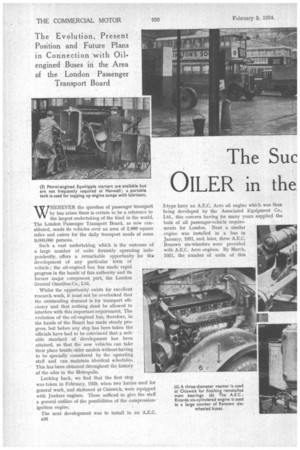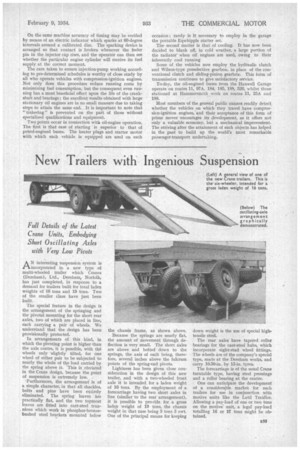The Suc
Page 90

Page 91

Page 92

Page 93

If you've noticed an error in this article please click here to report it so we can fix it.
ess of the
OILER in the
METROPOLIS
NxTHENEVER the question of passenger transport , 1 by bus arises there is certain to be a reference to the largest undertaking of the kind in the world. The London Passenger Transport Board, as now constituted, sends its vehicles over an area of 2,000 square miles and caters for the daily transport needs of some 9,000,000 persons.
Such a vast undertaking, which is the outcome of a large number of units formerly operating independently, offers a remarkable opportunity for the development of any particular form of vehicle ; the oil-engined bus has made rapid progress in the hands of this authority and its former major component part, the London General Omnibus Co., Ltd.
Whilst the opportunity exists for excellent • research work, it must not be overlooked that the outstanding demand is for transport efficiency and that nothing rhust be allowed to interfere with this important requirement. The evolution of the oil-engined bus, therefore, in the hands of the Board has made steady progress, but before any step has been taken the officials have had to be convinced that a suitable standard of development has been attained, so that the new vehicles can take their place beside older models without having to be specially considered by the operating staff and can maintain identical schedules. This has been obtained throughout the history of the oiler in the Metropolis.
Looking back, we find that the first step was taken in February, 1929, when two lorries used for general work, and stationed at Chiswick, were equipped with Junkers engines. These sufficed to give the staff a general outline of the possibilities of the compressionignition engine.
The next development was to install in an A.E.C. £32 5-type lorry an A.E.C. Acro oil engine which was then being developed by the Associated Equipment Co., Ltd., this concern having for many years supplied the bulk of all passenger-vehicle requirements for London. Next a similar engine was installed in a bus in January, 1931, and, later, three A.E.C. Renown six-wheelers were provided with A.E.C. Acro engines. By March, 1931, the number of units of this type installed in bus chassis had risen to 12.
Experience at Southall next produced the A.E.C. Ricardo oil engine with rotary-swirl combustion chambers, and the improvement which was revealed in these engines resulted in the previously mentioned 12 buses being converted to this form of power unit by the end of 1931. Twenty A.E.C. Renowns with the Ricardo-type engine were then pur nomh= chased, so that 32 oil-,engined vehicles of the one typa were running at the end of 1931.
During the following year further orders were placed, and October saw a total of 94 engines of the same class, all in service in Renown six-wheeled buses. In November of that year 11 buses were put to work with, Gardner 6LW-type engines, bringing the total of oilers for 1932 up to 105.
For reasons of operating efficiency and ease of supply, the whole of this number was stationed at the Hanwell Garage, there being no petrol-engined buses at the depot at the completion of the' change. In this way confusion could not arise when refuelling, and the maintenance staff acquired familiarity with the design, which promotes -efficiency.
At the close of 1933 the total of oil-engined buses had risen to 179. At the present time they are stationed at Hanwell and Hammefsmith Garages, the latter being in a process of conversion to house only vehicles of the type having the newer form of prime mover ; it now has some 87 oilers out of a little over 100 buseb.
It is hoped to reach over 400 oil-engined vehicles by the' latter part of this year. The fleet totals 5,253. Loncion General Country Services runs three injection-engined singledeckers. The fleet will be increased by two Leyland oilers when the City Motor Omnibus Co., Ltd., is taken over by the Board.
At the present time, records show that the compression-ignition engine gives art important saving in the fuel item. Unfortunately, the m.p.g. figure is confidential, but the result is certainly striking.
In looking forward it is obvious that the future of the oil engine as a power unit for London's passengertransport system in the streets is a bright one. The hard spade work has been done, and, as is shown hereafter, the standard of quality attained to-day is held by many to be at least equal to that of the petrol-engined bus, which is the outcome of a far longer period of work. An increase in the percentage of oilers seems to be a certainty.
The foregoing is the outline of the history of this phase of London's daily transport life. It is interesting to look back at certain of the difficulties which have successfully been overcome. One of the bugbears which was common to many makes was cracking of the big-end bearings. To-day, lead-bronze is used in the upper half of each of these bearings, and, to date, no failures have been recorded.
Weight difficulties have diminished, and the modern unit coining from the Southall factory is under 11 lb. per b.h.p., complete with its auxiliaries, so that no problem arises on this score. The A.E.C. engine will probably be
incorporated in four-wheeled buses at an early date, but at the moment, all the oilers are six-wheelers of the Renown type. •
Cilinder-bore wear now occasions no trouble, as hardened barrels, to the Board's own specification, having a Brinell reading of 400-500, have been standardized, and hardened piston rings work in conjunction with them.
Smoky exhausts, although they have occasioned no trouble in London, as they did on the Continent, have E34 been ruled out by two methods. First, it was found that an excess of fuel due to unskilled tuning would lead to the trouble, so that a current practice is to provide a sealed stop on each fuel pump, this limiting the maximum quantity injected per stroke. This may not be interfered with ,by the garage staff: therefore, it is impossible for a mechanic to give a more generous supply in the hope of getting more power which is not correctly attainable by this means.
The second course is to take exhaust-gas analyses for the carbon-dioxide, which must not exceed 8 per cent, at the maximum-delivery position of the control. These two courses not only attained the smoke-prevention objective, but increased the efficiency of running.
It is interesting to note that, whilst the fuel-pump maximum is set, there is no governor for the maximum speed, so that the engine's behaviour on the road is exactly -the same as that of its petrol counterpart. This was one of the requirements laid down by the London General Omnibus Co., Ltd., before these engines would be regarded as satisfactory service units.
One of the vital points of interest is, of course, the maintenance side. In the two garages concerned, Hanwell and Hammersmith, the repair work is limited. to decarbonizing, valve grinding, checking and cleaning of the injectors, a simple form of pump test, and fuel-filter cleaning.
On no account may a fuel pump be dismantled; it must be returned to the repair headquarters at Chiswick if it proves faulty. It has been found that the exhaust valves require less frequent attention than do those of petrol engines.
At Chiswick repair depot the compression-ignition units pass through the shops alongside petrol motors. This course is facilitated by the fact that the designs of the two types are, in many respects, similar, so that in a short time the staff becomes familiar witii the oilers.
Special-purpose machine tools are largely used for such work as boring cylinder liners, valve grinding, reamering main and big-end bearings, but many of these also serve for similar work on carburetter engines. One of the most interesting new appliances at Chiswick is a testing plant for fuel pumps. The camshaft is driven by an electric motor and the operator can see whether the fuel is blowing freely DOM all six injectors. When this is established the quantity delivered from each one is directed into graduated glass tubes and the quantity measured and equalized for 100 r.p.m. On the same machine accuracy of timing may be verified by means of an electric indicator which sparks at 60-degree intervals around a calibrated disc. The sparking device is arranged so that contact is broken whenever the feeler pin in the injector cap rises, and the operator can then see whether the particular engine cylinder will receive its fuel supply at the correct moment.
The care taken to ensure injection-pump working according to pre-determined schedules is worthy of close study by all who operate vehicles with compression-ignition engines. Not only does this procedure reduce running costs by minimizing fuel consumption, but the consequent even running has a most beneficial effect upon the life of the crankshaft and bearings ; the excellent results obtained with large stationary oil engines are in no small measure due to taking steps to attain the same end. It is important to note that " tinkering " is prevented on the part of those without specialized qualifications and equipment.
Two points occur in connection with oil-engine operation. The first is that ease of starting is superior to that of petrol-engined buses. The heater plugs and starter motor with which each vehicle is equipped are used on each occasion ; rarely is it necessary to employ in the garage the portable Eqwhipple starter set. The second matter is that of cooling. It has now been decided to blank off, in cold weather, a large portion of the radiator when oil engines are used, owing to their inherently cool running Some of the vehicles now employ the hydraulic clutch and Wilson-type preselective gearbox, in place of the conventional clutch and sliding-pinion gearbOx. This form of transmission continues to give satisfactory service.
To-day, the oil-engined buses from the Hanwell Garage operate on routes 11, 97A. 184, 185, 188, 520, whilst those stationed at Hammersmith work on routes 11, 25A and 188.
Most members of the general public cannot readily detect whether the vehicles on which they travel have compression-ignition engines, and their acceptance of this form of prime mover encourages its development, as it offers not only a. valuable economy, but a mechanical improvenient. The striving after the attainment of such objects has helped in the past to build up the world's most remarkable passenger-transport undertaking.




































































































































































